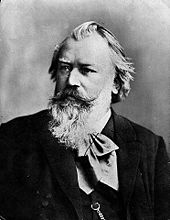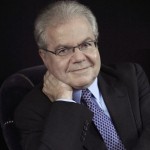Thursday, Nov. 17, 2022, San Francisco – The enthusiastic music lovers who filled Davies Symphony Hall were on the edges of their seats before the concert began. They were there for the splendid, colorful, soul searing, soul lifting Brahms music. They came to hail their recently retired Music Director, now Laureate of the San Francisco Symphony, Michael Tilson Thomas, hero of San Francisco and the world of music. They cheered pianist Emanuel Ax as they might for a rock star, one who is loved by a very wide range of ages. This was a great reunion of artists who have performed together for many years. The coordination and unity of Maestro, Pianist, and Composer was breathtaking. They seemed to breathe in unison. Yes, that included Brahms, the reason the others were there. When remembering the concert, I visualize its end: MTT and Emanuel Ax standing side by side with their arms linked. The SF Symphony performed at the height of their great musicality. The Brahms program could not be beat, and the image of the two men on stage lasts.
 Michael Tilson Thomas, Music Director Laureate, SF Symphony, conductor laureate of the London Symphony, co-founder and artistic director laureate of the New World Symphony.
Michael Tilson Thomas, Music Director Laureate, SF Symphony, conductor laureate of the London Symphony, co-founder and artistic director laureate of the New World Symphony.
The program opened with Serenade No. 1 in D major, Opus 11. This glorious, inventive piece is rarely performed. Johannes Brahms led his creation through several versions. He changed the instruments from an ensemble to a symphonic work, completed in 1858, and debuted its final version,1860. It could well have been a symphony, it has that grandeur, but it is a little more as Brahms includes two Minuets and two Scherzos. Its first movement starts with an easy going sound and develops by wandering happily through images and feelings. Toward the end, it begins to float like substantial but delicate summer clouds. The movement that follows begins with dark, threatening sounds as though proving that our lives are not lived only on sunny hillsides like the places where Brahms liked to visit and compose. And yet, he does not linger in the dark. He moves on to an Adagio that offers so much of Brahms’ heart that it invites profound sadness and then beams pure light as music. He follows with two Minuets. Surprisingly, the Minuets lead to another dark passage, but Brahms will not abandon us there. He takes off his hat and jacket and shows himself, the Brahms who can express love of life in its full, complex, troubling, loving nature. From then on in the next Scherzo and the final Rondo, the music puts on more muscle; it is the muscle of a thrilling dancer, flexible and strong. Brahms gives us a Rondo with the full-hearted power of joy.
 Johannes Brahms, (May, 7, 1833, Hamburg – April 3, 1897 Vienna)
Johannes Brahms, (May, 7, 1833, Hamburg – April 3, 1897 Vienna)
Brahms finished his Piano Concerto No. 1 in D minor, Opus 15 in 1858, the same year the Serenade in D major was begun. He began working on a sonata for two pianos, but he was not satisfied with his progress. He wrote to his friend, musician Joseph Joachim, “Actually, not even two pianos are enough for me.” His thoughts worked toward bigger expressions but held him back from writing his first symphony. That restraint lasted for 22 years and resulted in the immense, passionate, and astounding experience of his Symphony No. 1. Through years and much work, the Piano Concerto evolved. It opens with energy and grandeur. The piano does not join in for several minutes. Seeing Emanuel Ax sitting still at the piano added to the suspense begun at the very first sounds. Then, there is a gorgeous piano solo in which every listener luxuriates. “Go ahead,” the eternal music suggests, “feel the sun like a balm on your skin. Wrap yourself in a silken gown of sound.” It is a mysterious experience. Brahms bathes us in reality through his sound inventions. He is aware at all times of the complexity and wonder of life; he knows that we are all alive and gives us music that reminds us of the live moments all around us. In this fascinating, totally original concerto, Brahms switches from minor to major and sometimes combines them The result is a musical experience in all dimensions. His Adagio is in D major and has a solemn, quiet message. This great masterpiece of a Concerto brings us all together to open our eyes and hearts. Brahms embraces the world.
The huge ovation for the entire SF Symphony was encouraged by their generous leader, Michael Tillson Thomas. He gestured to every section, every soloist, and every player to take their bows. He and Emanuel Ax traded bows to the audience and to each other. And then, Mr. Ax gave us a gift from Schubert as an encore. He played the song, Seranade: “Softly my songs/cry to you through the night/come down to me my love/into the silent grove.” it was a concert to treasure.
It was a concert to treasure.
